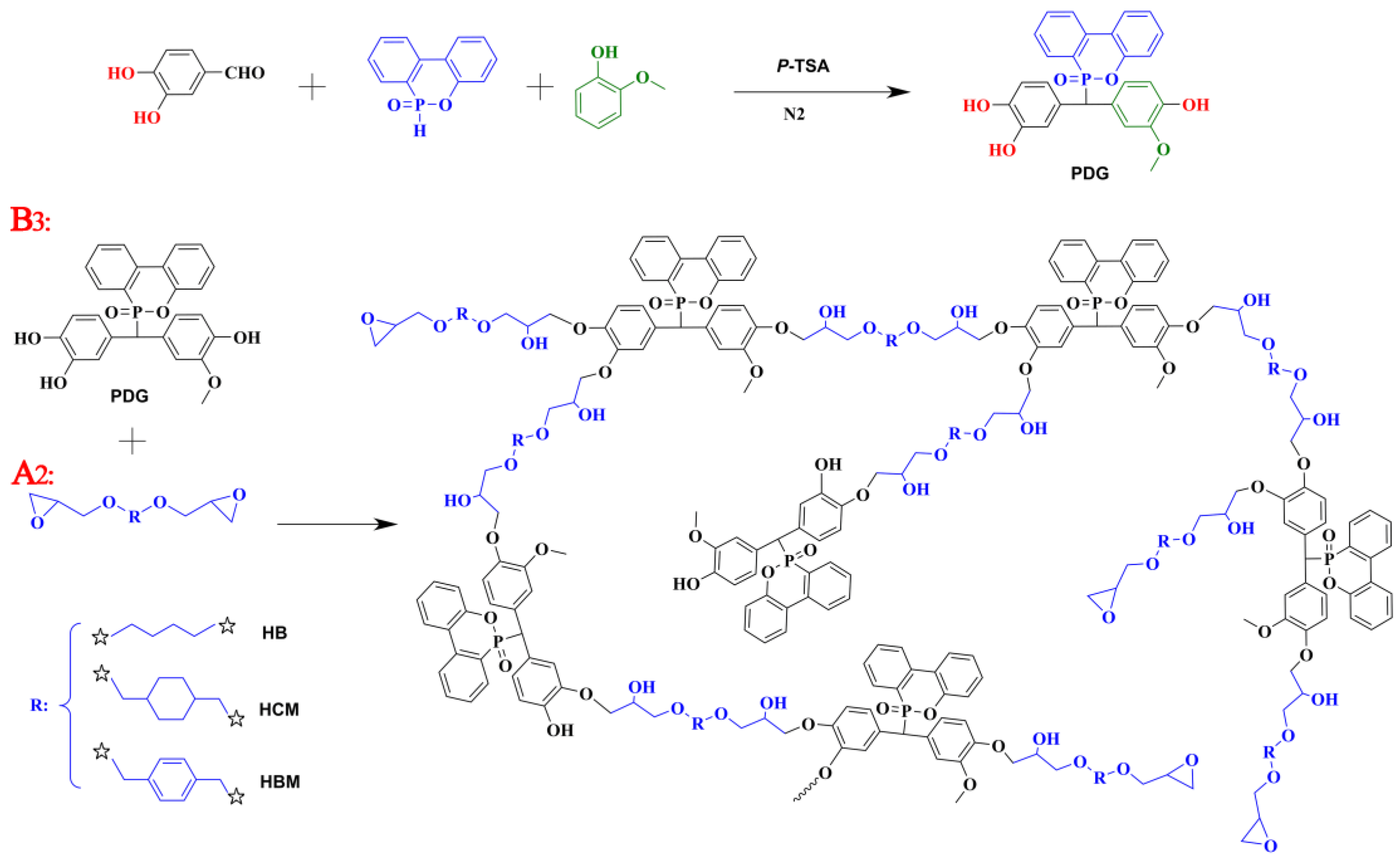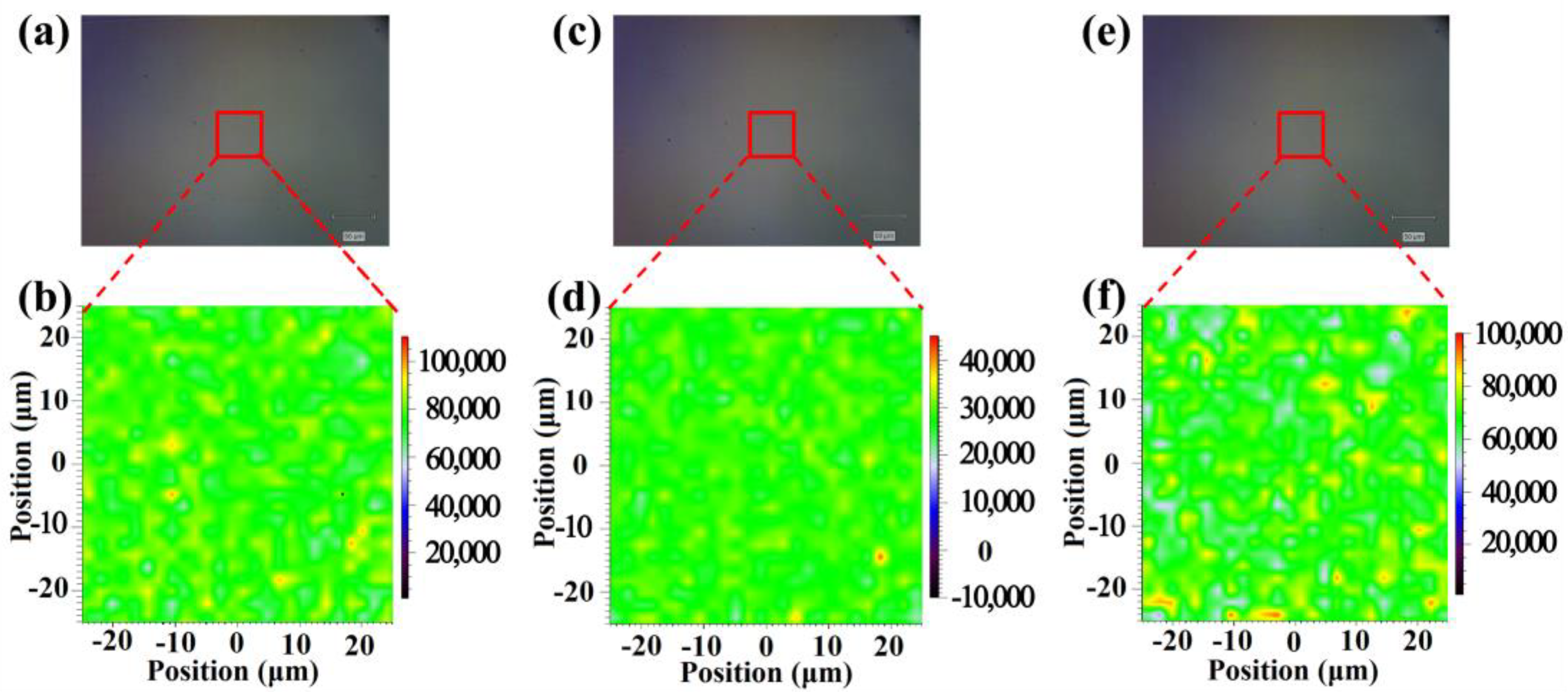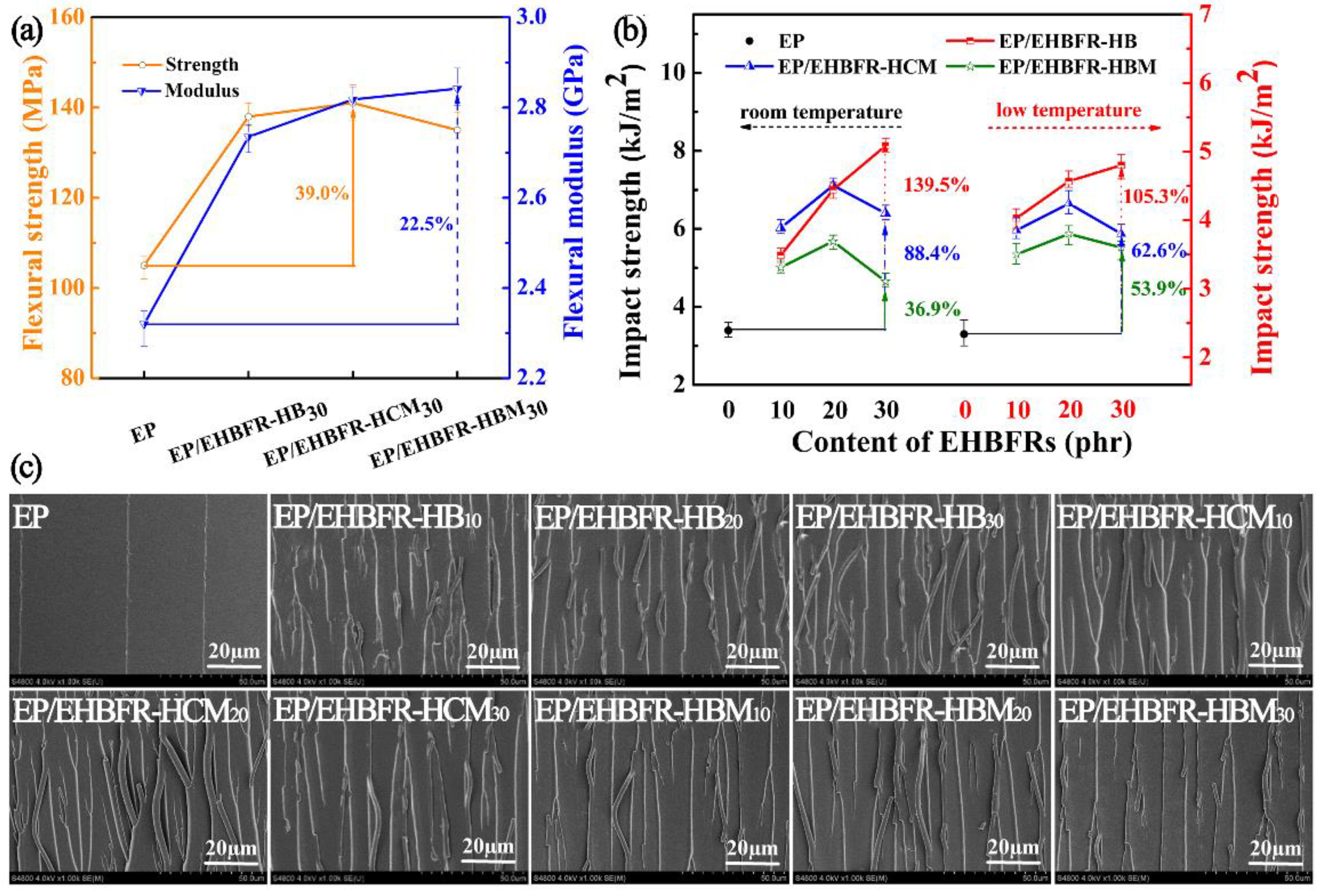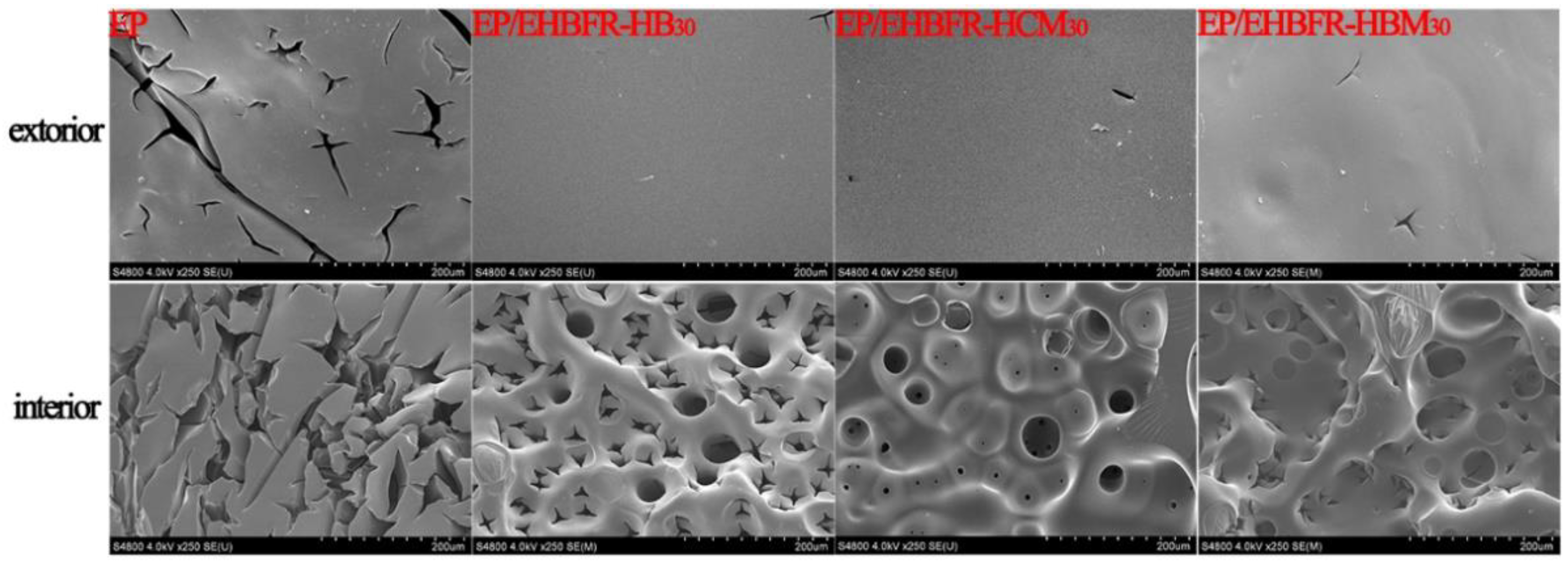Synthesis of Hyperbranched Flame Retardants with Varied Branched Chains’ Rigidity and Performance of Modified Epoxy Resins
Abstract
1. Introduction
2. Materials and Methods
2.1. Raw Materials
2.2. Synthesis of Diglycidyl Ether
2.3. Synthesis of EHBFR-HB, EHBFR-HCM, and EHBFR-HBM
2.4. Preparation of Flame-Retardant Epoxy Thermosets
2.5. Measurements
3. Results and Discussion
3.1. Synthesis and Characterization of EHBFR-HB, EHBFR-HCM, or EHBFR-HBM
3.2. Processability and Compatibility
3.3. Thermal Stability of Cured Resins
3.4. Thermal and Mechanical Properties
3.5. Flame-Retardant Performance
4. Conclusions
Supplementary Materials
Author Contributions
Funding
Institutional Review Board Statement
Informed Consent Statement
Data Availability Statement
Conflicts of Interest
References
- Jin, F.-L.; Li, X.; Park, S.-J. Synthesis and application of epoxy resins: A review. J. Ind. Eng. Chem. 2015, 29, 1–11. [Google Scholar] [CrossRef]
- Huo, S.; Song, P.; Yu, B.; Ran, S.; Chevali, V.S.; Liu, L.; Fang, Z.; Wang, H. Phosphorus-containing flame retardant epoxy thermosets: Recent advances and future perspectives. Prog. Polym. Sci. 2021, 114, 101366. [Google Scholar] [CrossRef]
- Xu, J.; Yang, J.; Wang, H.; Lin, P.; Liu, X.; Zhang, J.; Fu, S.; Tang, Y. Bio-Based Hyperbranched Toughener from Tannic Acid and Its Enhanced Solvent-Free Epoxy Resin with High Performance. J. Renew. Mater. 2019, 7, 1333–1346. [Google Scholar] [CrossRef]
- Ran, S.; Fang, F.; Guo, Z.; Song, P.; Cai, Y.; Fang, Z.; Wang, H. Synthesis of decorated graphene with P, N-containing compounds and its flame retardancy and smoke suppression effects on polylactic acid. Compos. Pt. B-Eng. 2019, 170, 41–50. [Google Scholar] [CrossRef]
- La Rosa, A.D.; Recca, A.; Carter, J.T.; McGrail, P.T. An oxygen index evaluation of flammability on modified epoxy/polyester systems. Polymer 1999, 40, 4093–4098. [Google Scholar] [CrossRef]
- Zhou, X.; Qiu, S.; Mu, X.; Zhou, M.; Cai, W.; Song, L.; Xing, W.; Hu, Y. Polyphosphazenes-based flame retardants: A review. Compos. Pt. B-Eng. 2020, 202, 108397. [Google Scholar] [CrossRef]
- Miao, J.; Fang, Y.; Yang, X.; Zhu, Y.; Hu, A.; Wang, G. Fabrication, flame retardancy and physical properties of phosphorus containing porous organic polymers/epoxy resin composites. Polym. Degrad. Stab. 2020, 176, 109159. [Google Scholar] [CrossRef]
- Wang, J.; Tang, H.; Yu, X.; Xu, J.; Pan, Z.; Zhou, H. Reactive organophosphorus flame retardant for transparency, low-flammability, and mechanical reinforcement epoxy resin. J. Appl. Polym. Sci. 2021, 138, 50536. [Google Scholar] [CrossRef]
- Zhang, J.; Duan, H.; Cao, J.; Zou, J.; Ma, H. A high-efficiency DOPO-based reactive flame retardant with bi-hydroxyl for low-flammability epoxy resin. J. Appl. Polym. Sci. 2020, 138, 50165. [Google Scholar] [CrossRef]
- Bao, Q.; Wang, B.; Liu, Y.; Wang, Q.; Yang, Z. Epoxy resin flame retarded and toughed via flexible siloxane chain containing phosphaphenanthrene. Polym. Degrad. Stab. 2020, 172, 109055. [Google Scholar] [CrossRef]
- Wang, X.; Zhou, S.; Guo, W.-W.; Wang, P.-L.; Xing, W.; Song, L.; Hu, Y. Renewable Cardanol-Based Phosphate as a Flame Retardant Toughening Agent for Epoxy Resins. ACS Sustain. Chem. Eng. 2017, 5, 3409–3416. [Google Scholar] [CrossRef]
- Fu, S.-Y.; Feng, X.-Q.; Lauke, B.; Mai, Y.-W. Effects of particle size, particle/matrix interface adhesion and particle loading on mechanical properties of particulate–polymer composites. Compos. Pt. B-Eng. 2008, 39, 933–961. [Google Scholar] [CrossRef]
- Gojny, F.H.; Wichmann, M.H.G.; Köpke, U.; Fiedler, B.; Schulte, K. Carbon nanotube-reinforced epoxy-composites: Enhanced stiffness and fracture toughness at low nanotube content. Compos. Sci. Technol. 2004, 64, 2363–2371. [Google Scholar] [CrossRef]
- Gao, C.; Yan, D. Hyperbranched polymers: From synthesis to applications. Prog. Polym. Sci. 2004, 29, 183–275. [Google Scholar] [CrossRef]
- Fei, X.; Wei, W.; Tang, Y.; Zhu, Y.; Luo, J.; Chen, M.; Liu, X. Simultaneous enhancements in toughness, tensile strength, and thermal properties of epoxy-anhydride thermosets with a carboxyl-terminated hyperbranched polyester. Eur. Polym. J. 2017, 90, 431–441. [Google Scholar] [CrossRef]
- Li, S.; Zhu, H.; Lv, T.; Lin, Q.; Hou, H.; Li, Y.; Wu, Q.; Cui, C. The effect of amino-terminated hyperbranched polymers on the impact resistance of epoxy resins. Colloid Polym. Sci. 2015, 294, 607–615. [Google Scholar] [CrossRef]
- Li, S.; Cui, C. Enhancing the mechanical properties of epoxy resin by addition of an amino-terminated hyperbranched polymer grown on glass fiber. J. Mater. Sci. 2015, 51, 1829–1837. [Google Scholar] [CrossRef]
- Lv, J.-Y.; Meng, Y.; He, L.-F.; Li, X.-Y.; Wang, H.-Q. Synthesis of a hyperbranched polyether epoxy through one-step proton transfer polymerization and its application as a toughener for epoxy resin DGEBA. Chin. J. Polym. Sci. 2012, 30, 493–502. [Google Scholar] [CrossRef]
- Zhang, J.; Mi, X.; Chen, S.; Xu, Z.; Zhang, D.; Miao, M.; Wang, J. A bio-based hyperbranched flame retardant for epoxy resins. Chem. Eng. Sci. 2020, 381, 122719. [Google Scholar] [CrossRef]
- Zang, L.; Wagner, S.; Ciesielski, M.; Müller, P.; Döring, M. Novel star-shaped and hyperbranched phosphorus-containing flame retardants in epoxy resins. Polym. Adv. Technol. 2011, 22, 1182–1191. [Google Scholar] [CrossRef]
- Täuber, K.; Marsico, F.; Wurm, F.R.; Schartel, B. Hyperbranched poly(phosphoester)s as flame retardants for technical and high performance polymers. Polym. Chem. 2014, 5, 7042–7053. [Google Scholar] [CrossRef]
- Battig, A.; Markwart, J.C.; Wurm, F.R.; Schartel, B. Matrix matters: Hyperbranched flame retardants in aliphatic and aromatic epoxy resins. Polym. Degrad. Stab. 2019, 170, 108986. [Google Scholar] [CrossRef]
- Battig, A.; Markwart, J.C.; Wurm, F.R.; Schartel, B. Correction: Hyperbranched phosphorus flame retardants: Multifunctional additives for epoxy resins. Polym. Chem. 2019, 10, 4621–4622. [Google Scholar] [CrossRef]
- Battig, A.; Müller, P.; Bertin, A.; Schartel, B. Hyperbranched Rigid Aromatic Phosphorus-Containing Flame Retardants for Epoxy Resins. Macromol. Mater. Eng. 2021, 306, 2000731. [Google Scholar] [CrossRef]
- Ma, C.; Qiu, S.; Yu, B.; Wang, J.; Wang, C.; Zeng, W.; Hu, Y. Economical and environment-friendly synthesis of a novel hyperbranched poly(aminomethylphosphine oxide-amine) as co-curing agent for simultaneous improvement of fire safety, glass transition temperature and toughness of epoxy resins. Chem. Eng. Sci. 2017, 322, 618–631. [Google Scholar] [CrossRef]
- Teng, N.; Dai, J.; Wang, S.; Liu, X.; Hu, J.; Yi, X.; Liu, X. Hyperbranched flame retardant to simultaneously improve the fire-safety, toughness and glass transition temperature of epoxy resin. Eur. Polym. J. 2021, 157, 110638. [Google Scholar] [CrossRef]
- Mezzenga, L.B.R.; Månson, J.-A.E. Effects of the Branching Architecture on the Reactivity of Epoxy-Amine Groups. Macromolecules 2000, 33, 4373–4379. [Google Scholar] [CrossRef]
- Bowen, D.O.; Whiteside, R.C. Effect of Hydroxyl Compounds on Reactivity of Epoxy Resins. Adv. Chem.Ser. 1970, 5, 48–59. [Google Scholar] [CrossRef]
- Yang, R.T.; Steinberg, M. Reaction Kinetics and Differential Thermal Analysis. Anal. Chem. 1957, 29, 1417–1421. [Google Scholar] [CrossRef]
- Ozawa, T. A new method of analyzing thermogravimetric data. Bull. Chem. Soc. Jpn. 1965, 38, 1881–1886. [Google Scholar] [CrossRef]
- Liu, J.; Dai, J.; Wang, S.; Peng, Y.; Cao, L.; Liu, X. Facile synthesis of bio-based reactive flame retardant from vanillin and guaiacol for epoxy resin. Compos. Pt. B-Eng. 2020, 190, 107926. [Google Scholar] [CrossRef]
- MERTES, H.S.a.J. Influence of the Structure on Thermoset Cure Kinetics. J. Polym. Sci. Part A Polym. Chem. 1993, 31, 2031–2037. [Google Scholar]
- Stoch, P.; Szczerba, W.; Bodnar, W.; Ciecinska, M.; Stoch, A.; Burkel, E. Structural properties of iron-phosphate glasses: Spectroscopic studies and ab initio simulations. Phys. Chem. Chem. Phys. 2014, 16, 19917–19927. [Google Scholar] [CrossRef]
- Dai, X.; Li, P.; Sui, Y.; Zhang, C. Thermal and flame-retardant properties of intrinsic flame-retardant epoxy resin containing biphenyl structures and phosphorus. Eur. Polym. J. 2021, 147, 110319. [Google Scholar] [CrossRef]
- Yang, S.; Huo, S.; Wang, J.; Zhang, B.; Wang, J.; Ran, S.; Fang, Z.; Song, P.; Wang, H. A highly fire-safe and smoke-suppressive single-component epoxy resin with switchable curing temperature and rapid curing rate. Compos. Pt. B-Eng. 2021, 207, 108601. [Google Scholar] [CrossRef]
- Wang, S.; Wu, Y.; Dai, J.; Teng, N.; Peng, Y.; Cao, L.; Liu, X. Making organic coatings greener: Renewable resource, solvent-free synthesis, UV curing and repairability. Eur. Polym. J. 2020, 123, 109439. [Google Scholar] [CrossRef]
- Wang, X.; Zong, L.; Han, J.; Wang, J.; Liu, C.; Jian, X. Toughening and reinforcing of benzoxazine resins using a new hyperbranched polyether epoxy as a non-phase-separation modifier. Polymer 2017, 121, 217–227. [Google Scholar] [CrossRef]
- Kumar, S.; Krishnan, S.; Samal, S.K.; Mohanty, S.; Nayak, S.K. Toughening of Petroleum Based (DGEBA) Epoxy Resins with Various Renewable Resources Based Flexible Chains for High Performance Applications: A Review. Ind. Eng. Chem. Res. 2018, 57, 2711–2726. [Google Scholar] [CrossRef]
- Liu, X.-F.; Liu, B.-W.; Luo, X.; Guo, D.-M.; Zhong, H.-Y.; Chen, L.; Wang, Y.-Z. A novel phosphorus-containing semi-aromatic polyester toward flame retardancy and enhanced mechanical properties of epoxy resin. Chem. Eng. Sci. 2020, 380, 122471. [Google Scholar] [CrossRef]
- Ma, C.; Qiu, S.; Wang, J.; Sheng, H.; Zhang, Y.; Hu, W.; Hu, Y. Facile synthesis of a novel hyperbranched poly(urethane-phosphine oxide) as an effective modifier for epoxy resin. Polym. Degrad. Stab. 2018, 154, 157–169. [Google Scholar] [CrossRef]
- Bach, Q.-V.; Vu, C.M.; Nguyen, D.D.; Kien, B.X. Impacts of phosphorous-linked epoxidized vegetable oil on mechanical behaviors and flammability properties of silica reinforced epoxy composite. Thermochim. Acta 2020, 691, 178722. [Google Scholar] [CrossRef]
- Zhu, M.; Liu, L.; Wang, Z. Mesoporous silica via self-assembly of nano zinc amino-tris-(methylenephosphonate) exhibiting reduced fire hazards and improved impact toughness in epoxy resin. J. Hazard. Mater. 2020, 392, 122343. [Google Scholar] [CrossRef]
- Li, Z.; Chen, M.; Li, S.; Fan, X.; Liu, C. Simultaneously Improving the Thermal, Flame-Retardant and Mechanical Properties of Epoxy Resins Modified by a Novel Multi-Element Synergistic Flame Retardant. Macromol. Mater. Eng. 2019, 304, 1800619. [Google Scholar] [CrossRef]
- Li, S.; Chen, M.; Su, L.; Lin, X.; Liu, C. Highly efficient multielement flame retardant for multifunctional epoxy resin with satisfactory thermal, flame-retardant, and mechanical properties. Polym. Adv. Technol. 2019, 31, 146–159. [Google Scholar] [CrossRef]
- Jian, R.K.; Ai, Y.F.; Xia, L.; Zhao, L.J.; Zhao, H.B. Single component phosphamide-based intumescent flame retardant with potential reactivity towards low flammability and smoke epoxy resins. J. Hazard. Mater. 2019, 371, 529–539. [Google Scholar] [CrossRef] [PubMed]
- Shi, Y.-Q.; Fu, T.; Xu, Y.-J.; Li, D.-F.; Wang, X.-L.; Wang, Y.-Z. Novel phosphorus-containing halogen-free ionic liquid toward fire safety epoxy resin with well-balanced comprehensive performance. Chem. Eng. Sci. 2018, 354, 208–219. [Google Scholar] [CrossRef]
- Luo, J.; Yang, S.; Lei, L.; Zhao, J.; Tong, Z. Toughening, synergistic fire retardation and water resistance of polydimethylsiloxane grafted graphene oxide to epoxy nanocomposites with trace phosphorus. Compos. Pt. A-Appl. Sci. Manuf. 2017, 100, 275–284. [Google Scholar] [CrossRef]
- Chen, M.; Lin, X.; Liu, C.; Zhang, H. An effective strategy to enhance the flame retardancy and mechanical properties of epoxy resin by using hyperbranched flame retardant. J. Mater. Sci. 2021, 56, 5956–5974. [Google Scholar] [CrossRef]









| Samples | Composition (phr) | Content of P (wt.%) | ||
|---|---|---|---|---|
| DGEBA | EHBFR | DDM | ||
| EP | 100 | 0 | 25.8 | 0 |
| EP/EHBFR-HB10 | 90 | 10 | 23.9 | 0.26 |
| EP/EHBFR-HB20 | 80 | 20 | 22.1 | 0.53 |
| EP/EHBFR-HB30 | 70 | 30 | 20.3 | 0.80 |
| EP/EHBFR-HCM10 | 90 | 10 | 23.8 | 0.24 |
| EP/EHBFR-HCM20 | 80 | 20 | 21.9 | 0.48 |
| EP/EHBFR-HCM30 | 70 | 30 | 20.0 | 0.73 |
| EP/EHBFR-HBM10 | 90 | 10 | 23.9 | 0.24 |
| EP/EHBFR-HBM20 | 80 | 20 | 22.0 | 0.49 |
| EP/EHBFR-HBM30 | 70 | 30 | 20.1 | 0.75 |
| Samples | Mn (g/mol) | PDI | DB | EV (mol/100 g) |
|---|---|---|---|---|
| EHBFR-HB | 3872 | 1.8 | 0.68 | 0.15 |
| EHBFR-HCM | 4393 | 1.9 | 0.72 | 0.13 |
| EHBFR-HBM | 4261 | 2.0 | 0.69 | 0.14 |
| Samples |
Td5 (°C) |
R800 (%) | Tg Based on DSC (°C) | Tg Based on DMA (°C) |
Veʹ
(×103 mol·m−3) |
αv,g (×10−6 K−1) | αv,r (×10−6) | Δαv,r (×10−6) |
|---|---|---|---|---|---|---|---|---|
| EP | 389 | 14.99 | 168 | 172 | 4.03 | 63.9 | 166.0 | 102.1 |
| EP/EHBFR-HB10 | 380 | 17.50 | 160 | 169 | 5.04 | 61.5 | 171.8 | 110.3 |
| EP/EHBFR-HB20 | 373 | 17.85 | 155 | 160 | 5.45 | 60.8 | 177.2 | 116.4 |
| EP/EHBFR-HB30 | 362 | 19.54 | 147 | 151 | 5.48 | 60.3 | 177.4 | 117.1 |
| EP/EHBFR-HCM10 | 382 | 16.31 | 174 | 183 | 5.04 | 61.5 | 172.4 | 110.9 |
| EP/EHBFR-HCM20 | 375 | 18.79 | 162 | 173 | 5.28 | 60.3 | 177.8 | 117.5 |
| EP/EHBFR-HCM30 | 367 | 19.35 | 152 | 161 | 4.95 | 59.7 | 178.7 | 119.0 |
| EP/EHBFR-HBM10 | 385 | 16.79 | 169 | 179 | 4.38 | 60.9 | 175.7 | 114.8 |
| EP/EHBFR-HBM20 | 383 | 22.04 | 156 | 167 | 5.03 | 59.3 | 179.0 | 119.7 |
| EP/EHBFR-HBM30 | 377 | 23.95 | 151 | 160 | 4.12 | 58.8 | 179.7 | 120.9 |
| Increment in Strength/% | Increment in Tg/% | Increment in Toughness/% | Reference |
|---|---|---|---|
| 12.4 | −4.3 | 25 | [39] a |
| 3.5 | 0.3 | 32.3 | [40] b |
| −2.9 | 6.7 | 51 | [25] a |
| 22.7 | 3.1 | 85.5 | [41] b |
| 1.8 | −1.8 | 26.9 | [42] b |
| 3.1 | 2.5 | 38.2 | [43] a (EP-1) |
| 17.4 | 0.6 | 45.4 | [43] a (EP-2) |
| 5.8 | 1.1 | 37.7 | [44] a (EP-2) |
| 11.3 | 0.7 | 45.9 | [44] a (EP-3) |
| 12.8 | −0.6 | 50.4 | [44] a (EP-4) |
| 15.6 | −6.5 | 63.9 | [44] a (EP-5) |
| 21.4 | −13.2 | 45.5 | [45] a (EP2) |
| 20.4 | −9.6 | 59.1 | [45] a (EP3) |
| −11.3 | −2.9 | −13.3 | [46] b (EP-4.0) |
| −16.7 | −3.5 | −11.6 | [46] b (EP-7.5) |
| 36 | 1.4 | −29.7 | [47] a |
| 37.5 | 3.1 | 55.4 | [48] a |
| 31.4 | −12.2 | 139.5 | EP/EHBFR-HB30 |
| 34.3 | −6.3 | 88.4 | EP/EHBFR-HCM30 |
| 28.6 | −7.0 | 36.9 | EP/EHBFR-HBM30 |
Disclaimer/Publisher’s Note: The statements, opinions and data contained in all publications are solely those of the individual author(s) and contributor(s) and not of MDPI and/or the editor(s). MDPI and/or the editor(s) disclaim responsibility for any injury to people or property resulting from any ideas, methods, instructions or products referred to in the content. |
© 2023 by the authors. Licensee MDPI, Basel, Switzerland. This article is an open access article distributed under the terms and conditions of the Creative Commons Attribution (CC BY) license (https://creativecommons.org/licenses/by/4.0/).
Share and Cite
Hu, J.; Zhang, L.; Chen, M.; Dai, J.; Teng, N.; Zhao, H.; Ba, X.; Liu, X. Synthesis of Hyperbranched Flame Retardants with Varied Branched Chains’ Rigidity and Performance of Modified Epoxy Resins. Polymers 2023, 15, 449. https://doi.org/10.3390/polym15020449
Hu J, Zhang L, Chen M, Dai J, Teng N, Zhao H, Ba X, Liu X. Synthesis of Hyperbranched Flame Retardants with Varied Branched Chains’ Rigidity and Performance of Modified Epoxy Resins. Polymers. 2023; 15(2):449. https://doi.org/10.3390/polym15020449
Chicago/Turabian StyleHu, Jingyuan, Liyue Zhang, Mingxuan Chen, Jinyue Dai, Na Teng, Hongchi Zhao, Xinwu Ba, and Xiaoqing Liu. 2023. "Synthesis of Hyperbranched Flame Retardants with Varied Branched Chains’ Rigidity and Performance of Modified Epoxy Resins" Polymers 15, no. 2: 449. https://doi.org/10.3390/polym15020449
APA StyleHu, J., Zhang, L., Chen, M., Dai, J., Teng, N., Zhao, H., Ba, X., & Liu, X. (2023). Synthesis of Hyperbranched Flame Retardants with Varied Branched Chains’ Rigidity and Performance of Modified Epoxy Resins. Polymers, 15(2), 449. https://doi.org/10.3390/polym15020449





